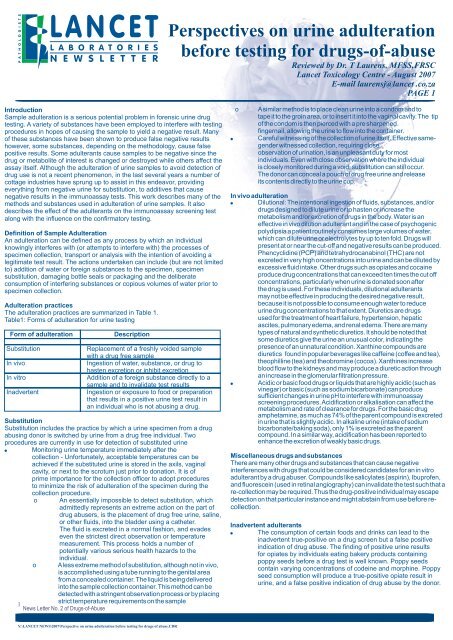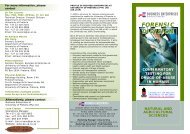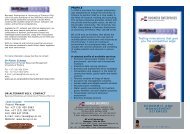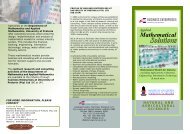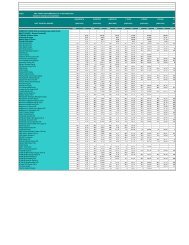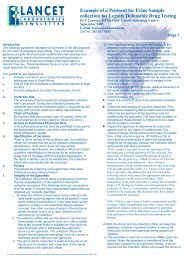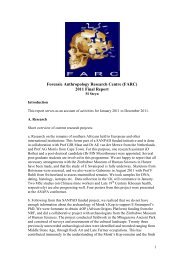Perspectives on urine adulteration before testing for drugs of abuse
Perspectives on urine adulteration before testing for drugs of abuse
Perspectives on urine adulteration before testing for drugs of abuse
You also want an ePaper? Increase the reach of your titles
YUMPU automatically turns print PDFs into web optimized ePapers that Google loves.
P A T H O L O G I S T S<br />
LANCET<br />
L A B O R A T O R I E S<br />
N E W S L E T T E R<br />
<str<strong>on</strong>g>Perspectives</str<strong>on</strong>g> <strong>on</strong> <strong>urine</strong> adulterati<strong>on</strong><br />
<strong>be<strong>for</strong>e</strong> <strong>testing</strong> <strong>for</strong> <strong>drugs</strong>-<strong>of</strong>-<strong>abuse</strong><br />
Reviewed by Dr. T Laurens, MFSS,FRSC<br />
Lancet Toxicology Centre - August 2007<br />
E-mail laurensj@lancet .co.za<br />
PAGE 1<br />
Introducti<strong>on</strong><br />
Sample adulterati<strong>on</strong> is a serious potential problem in <strong>for</strong>ensic <strong>urine</strong> drug<br />
<strong>testing</strong>. A variety <strong>of</strong> substances have been employed to interfere with <strong>testing</strong><br />
procedures in hopes <strong>of</strong> causing the sample to yield a negative result. Many<br />
<strong>of</strong> these substances have been shown to produce false negative results<br />
however, some substances, depending <strong>on</strong> the methodology, cause false<br />
positive results. Some adulterants cause samples to be negative since the<br />
drug or metabolite <strong>of</strong> interest is changed or destroyed while others affect the<br />
assay itself. Although the adulterati<strong>on</strong> <strong>of</strong> <strong>urine</strong> samples to avoid detecti<strong>on</strong> <strong>of</strong><br />
drug use is not a recent phenomen<strong>on</strong>, in the last several years a number <strong>of</strong><br />
cottage industries have sprung up to assist in this endeavor, providing<br />
everything from negative <strong>urine</strong> <strong>for</strong> substituti<strong>on</strong>, to additives that cause<br />
negative results in the immunoassay tests. This work describes many <strong>of</strong> the<br />
methods and substances used in adulterati<strong>on</strong> <strong>of</strong> <strong>urine</strong> samples. It also<br />
describes the effect <strong>of</strong> the adulterants <strong>on</strong> the immunoassay screening test<br />
al<strong>on</strong>g with the influence <strong>on</strong> the c<strong>on</strong>firmatory <strong>testing</strong>.<br />
Definiti<strong>on</strong> <strong>of</strong> Sample Adulterati<strong>on</strong><br />
An adulterati<strong>on</strong> can be defined as any process by which an individual<br />
knowingly interferes with (or attempts to interfere with) the processes <strong>of</strong><br />
specimen collecti<strong>on</strong>, transport or analysis with the intenti<strong>on</strong> <strong>of</strong> avoiding a<br />
legitimate test result. The acti<strong>on</strong>s undertaken can include (but are not limited<br />
to) additi<strong>on</strong> <strong>of</strong> water or <strong>for</strong>eign substances to the specimen, specimen<br />
substituti<strong>on</strong>, damaging bottle seals or packaging and the deliberate<br />
c<strong>on</strong>sumpti<strong>on</strong> <strong>of</strong> interfering substances or copious volumes <strong>of</strong> water prior to<br />
specimen collecti<strong>on</strong>.<br />
Adulterati<strong>on</strong> practices<br />
The adulterati<strong>on</strong> practices are summarized in Table 1.<br />
Table1: Forms <strong>of</strong> adulterati<strong>on</strong> <strong>for</strong> <strong>urine</strong> <strong>testing</strong><br />
Form <strong>of</strong> adulterati<strong>on</strong><br />
Substituti<strong>on</strong><br />
In vivo<br />
In vitro<br />
Inadvertent<br />
Descripti<strong>on</strong><br />
Replacement <strong>of</strong> a freshly voided sample<br />
with a drug free sample<br />
Ingesti<strong>on</strong> <strong>of</strong> water, substance, or drug to<br />
hasten excreti<strong>on</strong> or inhibit excreti<strong>on</strong><br />
Additi<strong>on</strong> <strong>of</strong> a <strong>for</strong>eign substance directly to a<br />
sample and to invalidate test results<br />
Ingesti<strong>on</strong> or exposure to food or preparati<strong>on</strong><br />
that results in a positive <strong>urine</strong> test result in<br />
an individual who is not abusing a drug.<br />
Substituti<strong>on</strong><br />
Substituti<strong>on</strong> includes the practice by which a <strong>urine</strong> specimen from a drug<br />
abusing d<strong>on</strong>or is switched by <strong>urine</strong> from a drug free individual. Two<br />
procedures are currently in use <strong>for</strong> detecti<strong>on</strong> <strong>of</strong> substituted <strong>urine</strong><br />
M<strong>on</strong>itoring <strong>urine</strong> temperature immediately after the<br />
collecti<strong>on</strong> - Un<strong>for</strong>tunately, acceptable temperatures can be<br />
achieved if the substituted <strong>urine</strong> is stored in the axils, vaginal<br />
cavity, or next to the scrotum just prior to d<strong>on</strong>ati<strong>on</strong>. It is <strong>of</strong><br />
prime importance <strong>for</strong> the collecti<strong>on</strong> <strong>of</strong>ficer to adopt procedures<br />
to minimize the risk <strong>of</strong> adulterati<strong>on</strong> <strong>of</strong> the specimen during the<br />
collecti<strong>on</strong> procedure.<br />
o<br />
o<br />
An essentially impossible to detect substituti<strong>on</strong>, which<br />
admittedly represents an extreme acti<strong>on</strong> <strong>on</strong> the part <strong>of</strong><br />
drug <strong>abuse</strong>rs, is the placement <strong>of</strong> drug free <strong>urine</strong>, saline,<br />
or other fluids, into the bladder using a catheter.<br />
The fluid is excreted in a normal fashi<strong>on</strong>, and evades<br />
even the strictest direct observati<strong>on</strong> or temperature<br />
measurement. This process holds a number <strong>of</strong><br />
potentially various serious health hazards to the<br />
individual.<br />
A less extreme method <strong>of</strong> substituti<strong>on</strong>, although not in vivo,<br />
is accomplished using a tube running to the genital area<br />
from a c<strong>on</strong>cealed c<strong>on</strong>tainer. The liquid is being delivered<br />
into the sample collecti<strong>on</strong> c<strong>on</strong>tainer. This method can be<br />
detected with a stringent observati<strong>on</strong> process or by placing<br />
strict temperature requirements <strong>on</strong> the sample<br />
1 News Letter No. 2 <strong>of</strong> Drugs-<strong>of</strong>-Abuse<br />
<br />
o<br />
A similar method is to place clean <strong>urine</strong> into a c<strong>on</strong>dom and to<br />
tape it to the groin area, or to insert it into the vaginal cavity. The tip<br />
<strong>of</strong> the c<strong>on</strong>dom is then pierced with a pre sharpened<br />
fingernail, allowing the <strong>urine</strong> to flow into the c<strong>on</strong>tainer.<br />
Careful witnessing <strong>of</strong> the collecti<strong>on</strong> <strong>of</strong> <strong>urine</strong> itself. Effective samegender<br />
witnessed collecti<strong>on</strong>, requiring close<br />
observati<strong>on</strong> <strong>of</strong> urinati<strong>on</strong>, is an unpleasant duty <strong>for</strong> most<br />
individuals. Even with close observati<strong>on</strong> where the individual<br />
is closely m<strong>on</strong>itored during a void, substituti<strong>on</strong> can still occur.<br />
The d<strong>on</strong>or can c<strong>on</strong>ceal a pouch <strong>of</strong> drug free <strong>urine</strong> and release<br />
its c<strong>on</strong>tents directly to the <strong>urine</strong> cup.<br />
In vivo adulterati<strong>on</strong><br />
Diluti<strong>on</strong>al: The intenti<strong>on</strong>al ingesti<strong>on</strong> <strong>of</strong> fluids, substances, and/or<br />
<strong>drugs</strong> designed to dilute <strong>urine</strong> or to hasten or increase the<br />
metabolism and/or excreti<strong>on</strong> <strong>of</strong> <strong>drugs</strong> in the body. Water is an<br />
effective in vivo diluti<strong>on</strong> adulterant and in the case <strong>of</strong> psychogenic<br />
polydipsia a patient routinely c<strong>on</strong>sumes large volumes <strong>of</strong> water,<br />
which can dilute <strong>urine</strong> or electrolytes by up to ten fold. Drugs will<br />
present at or near the cut-<strong>of</strong>f and negative results can be produced.<br />
Phencyclidine (PCP) and tetrahydrocanabinol (THC) are not<br />
excreted in very high <strong>on</strong>centrati<strong>on</strong>s into <strong>urine</strong> and can be diluted by<br />
excessive fluid intake. Other <strong>drugs</strong> such as opiates and cocaine<br />
produce drug c<strong>on</strong>centrati<strong>on</strong>s that can exceed ten times the cut <strong>of</strong>f<br />
c<strong>on</strong>centrati<strong>on</strong>s, particularly when <strong>urine</strong> is d<strong>on</strong>ated so<strong>on</strong> after<br />
the drug is used. For these individuals, diluti<strong>on</strong>al adulterants<br />
may not be effective in producing the desired negative result,<br />
because it is not possible to c<strong>on</strong>sume enough water to reduce<br />
<strong>urine</strong> drug c<strong>on</strong>centrati<strong>on</strong>s to that extent. Diuretics are <strong>drugs</strong><br />
used <strong>for</strong> the treatment <strong>of</strong> heart failure, hypertensi<strong>on</strong>, hepatic<br />
ascites, pulm<strong>on</strong>ary edema, and renal edema. There are many<br />
types <strong>of</strong> natural and synthetic diuretics. It should be noted that<br />
some diuretics give the <strong>urine</strong> an unusual color, indicating the<br />
presence <strong>of</strong> an unnatural c<strong>on</strong>diti<strong>on</strong>. Xanthine compounds are<br />
diuretics found in popular beverages like caffeine (c<strong>of</strong>fee and tea),<br />
theophilline (tea) and theobromine (cocoa). Xanthines increase<br />
blood flow to the kidneys and may produce a diuretic acti<strong>on</strong> through<br />
an increase in the glomerular filtrati<strong>on</strong> pressure.<br />
Acidic or basic food <strong>drugs</strong> or liquids that are highly acidic (such as<br />
vinegar) or basic (such as sodium bicarb<strong>on</strong>ate) can produce<br />
sufficient changes in <strong>urine</strong> pH to interfere with immunoassay<br />
screening procedures. Acidificati<strong>on</strong> or alkalisati<strong>on</strong> can affect the<br />
metabolism and rate <strong>of</strong> clearance <strong>for</strong> <strong>drugs</strong>. For the basic drug<br />
amphetamine, as much as 74% <strong>of</strong> the parent compound is excreted<br />
in <strong>urine</strong> that is slightly acidic. In alkaline <strong>urine</strong> (intake <strong>of</strong> sodium<br />
bicarb<strong>on</strong>ate/baking soda), <strong>on</strong>ly 1% is excreted as the parent<br />
compound. In a similar way, acidificati<strong>on</strong> has been reported to<br />
enhance the excreti<strong>on</strong> <strong>of</strong> weakly basic <strong>drugs</strong>.<br />
Miscellaneous <strong>drugs</strong> and substances<br />
There are many other <strong>drugs</strong> and substances that can cause negative<br />
interferences with <strong>drugs</strong> that could be c<strong>on</strong>sidered candidates <strong>for</strong> an in vitro<br />
adulterant by a drug <strong>abuse</strong>r. Compounds like salicylates (aspirin), Ibupr<strong>of</strong>en,<br />
and fluorescein (used in retinal angiography) can invalidate the test such that a<br />
re-collecti<strong>on</strong> may be required. Thus the drug-positive individual may escape<br />
detecti<strong>on</strong> <strong>on</strong> that particular instance and might abstain from use <strong>be<strong>for</strong>e</strong> recollecti<strong>on</strong>.<br />
Inadvertent adulterants<br />
The c<strong>on</strong>sumpti<strong>on</strong> <strong>of</strong> certain foods and drinks can lead to the<br />
inadvertent true-positive <strong>on</strong> a drug screen but a false positive<br />
indicati<strong>on</strong> <strong>of</strong> drug <strong>abuse</strong>. The finding <strong>of</strong> positive <strong>urine</strong> results<br />
<strong>for</strong> opiates by individuals eating bakery products c<strong>on</strong>taining<br />
poppy seeds <strong>be<strong>for</strong>e</strong> a drug test is well known. Poppy seeds<br />
c<strong>on</strong>tain varying c<strong>on</strong>centrati<strong>on</strong>s <strong>of</strong> codeine and morphine. Poppy<br />
seed c<strong>on</strong>sumpti<strong>on</strong> will produce a true-positive opiate result in<br />
<strong>urine</strong>, and a false positive indicati<strong>on</strong> <strong>of</strong> drug <strong>abuse</strong> by the d<strong>on</strong>or.<br />
Y:\LANCET NEWS\2007\Perspective <strong>on</strong> <strong>urine</strong> adulterati<strong>on</strong> <strong>be<strong>for</strong>e</strong> <strong>testing</strong> <strong>for</strong> <strong>drugs</strong> <strong>of</strong> <strong>abuse</strong>.CDR
P A T H O L O G I S T S<br />
LANCET<br />
L A B O R A T O R I E S<br />
N E W S L E T T E R<br />
Food produced from farm animals is naturally rich in<br />
creatinine. This byproduct <strong>of</strong> muscle metabolism in the animal<br />
is identical to that produced in humans. There<strong>for</strong>e, the<br />
c<strong>on</strong>sumpti<strong>on</strong> <strong>of</strong> meat temporarily increases serum and <strong>urine</strong><br />
creatinine c<strong>on</strong>centrati<strong>on</strong>s. This may obscure the laboratory's<br />
attempts to identify diluted human specimens if creatinine is<br />
the <strong>on</strong>ly diluti<strong>on</strong>al marker used.<br />
There are several examples whereby prescripti<strong>on</strong> <strong>drugs</strong> can<br />
produce falsely positive immunoassay results <strong>for</strong> targeted<br />
<strong>drugs</strong>-<strong>of</strong>-<strong>abuse</strong>. Well known examples include:<br />
o Sympathomimetic amines in the amphetamine assay.<br />
o Hydrocod<strong>on</strong>e and hydromorph<strong>on</strong>e in the opiate<br />
o Cyclobenzaprine in the tricyclic antidepressant.<br />
These <strong>drugs</strong> have chemical structures similar to the target<br />
compounds and cross-reactivity is due to the inability <strong>of</strong> the<br />
antibody to ecognize the subtle differences.<br />
In vitro adulterants<br />
Household items and over the counter pharmaceutical products are<br />
popular in vitro adulterants since they are readily available in bathroom<br />
closets, pockets, and purses. Table 2 summarizes some <strong>of</strong> the effects that<br />
household products can have <strong>on</strong> immunoassay screening.<br />
Table 2: Effect <strong>of</strong> adulterants <strong>on</strong> immunoassays <strong>for</strong> <strong>drugs</strong> <strong>of</strong> <strong>abuse</strong><br />
Adulterant Amphetamines Barbiturates Benzodiazepines Cocaine Opiates PCP THC<br />
Amm<strong>on</strong>ia +R<br />
-R<br />
-R<br />
-All<br />
-C<br />
-E;-C<br />
-C<br />
-R<br />
-C<br />
+F;-C<br />
-E;-C<br />
-E;-C<br />
-C<br />
-All<br />
-F<br />
-C<br />
+F;-C<br />
-E;-C<br />
-E<br />
-All<br />
-C<br />
-C<br />
-F<br />
-All<br />
-C<br />
-C<br />
-E;-F;-C<br />
-R;-E;-C<br />
-R;-E<br />
+F<br />
+F<br />
+F<br />
+F<br />
-E<br />
+R;-E;+F<br />
-E<br />
-R;-E;-C<br />
+R;-E;+F<br />
-R<br />
-R -R<br />
Ascorbate<br />
Bicarb<strong>on</strong>ate<br />
Bleach<br />
Detergent<br />
Drano<br />
Golden seal<br />
Hand soap<br />
Joy<br />
Lime<br />
Peroxide<br />
Phosphate<br />
Salt<br />
Vanish<br />
Vinegar<br />
Visine<br />
R=RIA<br />
E=EMIT<br />
F=FPIA<br />
C=CEDIA<br />
-E<br />
-R<br />
-E<br />
-E;+F<br />
Commercial adulterants: The paranoia surrounding drug <strong>testing</strong> has<br />
spurned a 'cottage industry' <strong>of</strong> companies that are <strong>for</strong>mulating and<br />
marketing in vivo and in vitro adulterants. These products are widely<br />
available through the World Wide Web. Typical trade names are: 'UrinAid',<br />
'Mary Jane's super Clean 13', 'Urine Luck' etc. All the commercial products<br />
c<strong>on</strong>tain products acting as:<br />
Surfactants (alkylephoxysulph<strong>on</strong>ate)<br />
Fixatives (Gluteraldehyde),<br />
Acids (HCl 1.7 2.1 M),<br />
Oxidants (Nitrite, Pyridinium chlorochromate, Chromate,<br />
Peroxsidase, Chloride)<br />
Mechanism <strong>of</strong> acti<strong>on</strong> <strong>for</strong> adulterants<br />
Photometric interferences Causing an optical interference<br />
during analysis.<br />
Alterati<strong>on</strong>s <strong>of</strong> pH - Most enzymes have a narrow pH range by<br />
which activity is optimized (vinegar, lem<strong>on</strong> juice,<br />
bicarb<strong>on</strong>ate, and alkaline detergents)<br />
Antibody-antigen interacti<strong>on</strong>s - All immuno assays rely <strong>on</strong> specific<br />
interacti<strong>on</strong> between antibodies from the assay and the antigens<br />
-E<br />
-E<br />
-R;-F<br />
-E<br />
<str<strong>on</strong>g>Perspectives</str<strong>on</strong>g> <strong>on</strong> <strong>urine</strong> adulterati<strong>on</strong><br />
<strong>be<strong>for</strong>e</strong> <strong>testing</strong> <strong>for</strong> <strong>drugs</strong>-<strong>of</strong>-<strong>abuse</strong><br />
Reviewed by Dr. T Laurens, MFSS, FRSC<br />
Lancet Toxicology Centre - August 2007<br />
E-mail laurensj@lancet .co.za<br />
PAGE 2<br />
-F<br />
-E<br />
-R<br />
-R<br />
-E<br />
-E<br />
-R<br />
-E;-F<br />
-R;-E;-C<br />
<br />
(<strong>drugs</strong>) from the specimens. This delicate balance can be disrupted<br />
by changes in pH, i<strong>on</strong>ic strength, viscosity, and surface tensi<strong>on</strong>.<br />
Miscellaneous interacti<strong>on</strong>s - Benzalk<strong>on</strong>ium chloride promotes<br />
the sequestrati<strong>on</strong> <strong>of</strong> THC into micelle bodies, making it unavailable<br />
<strong>for</strong> binding to THC specific antibodies<br />
Interferences in Point-<strong>of</strong>-Care drug <strong>testing</strong> systems<br />
Most <strong>of</strong> these assays make use <strong>of</strong> immuno chromatography,<br />
whereby antibodies are immobilized <strong>on</strong>to a solid support in a strip,<br />
to capture and detect <strong>drugs</strong> as they pass through in the aqueous<br />
mobile phase.<br />
To date, there have been no studies c<strong>on</strong>ducted <strong>on</strong> the per<strong>for</strong>mance<br />
<strong>of</strong> these devices in the presence <strong>of</strong> in vitro adulterants. The course<br />
<strong>of</strong> the designing <strong>of</strong> these assays is significantly different from the<br />
soluti<strong>on</strong> based laboratory assays. It is possible that the adulterants<br />
discussed in the previous secti<strong>on</strong> will not behave in the same<br />
manner. For example, adulterants that retard or impede flow to the<br />
targeted areas will produce interferences in point-<strong>of</strong>-care devices<br />
that will not be observed <strong>on</strong> instrument based immunoassays.<br />
Point-<strong>of</strong>-care devices have built in procedural positive c<strong>on</strong>trols<br />
that enable the analyst to see whether the sample has migrated to<br />
an area where the antibodies are immobilized.<br />
Poit-<strong>of</strong>-care devices are designed to be used by individuals<br />
with c<strong>on</strong>siderable less experience and training than qualified<br />
technologists employed in accredited toxicology laboratories.<br />
Adulterants that act by interfering with antibody-antigen reacti<strong>on</strong>s,<br />
is likely to affect point-<strong>of</strong>-care <strong>testing</strong> in the same manner as<br />
laboratory-based immunoassays.<br />
Interference <strong>of</strong> adulterants in c<strong>on</strong>firmati<strong>on</strong> procedures<br />
C<strong>on</strong>firmati<strong>on</strong> <strong>of</strong> the presence <strong>of</strong> a drug or its metabolite in <strong>urine</strong> samples is<br />
most <strong>of</strong>ten carried out using a sophisticated analytical procedure and<br />
instrumentati<strong>on</strong> such as GC-MS. With the absolute specificity <strong>of</strong> a properly<br />
c<strong>on</strong>ducted assay, it is rare <strong>for</strong> an adulterant to interfere with the <strong>testing</strong><br />
process (unless the target compound has been altered by an adulterant e.g.<br />
by oxidati<strong>on</strong>). The entire analytical procedure must be sufficiently robust to<br />
prevent extremes <strong>of</strong> pH to affect extracti<strong>on</strong>, or loss <strong>of</strong> derivatizing reagent<br />
due to reacti<strong>on</strong> with a high c<strong>on</strong>centrati<strong>on</strong> <strong>of</strong> adulterant (in which case a<br />
competiti<strong>on</strong> between the derivatizing agent and analyte will result).<br />
Laboratory detecti<strong>on</strong> adulterants<br />
The aim <strong>of</strong> validity <strong>testing</strong> is to dem<strong>on</strong>strate that the sample submitted <strong>for</strong><br />
analysis is in fact <strong>urine</strong>. The validity <strong>of</strong> the sample must be checked <strong>be<strong>for</strong>e</strong><br />
the screening process commences. The minimum validity tests that must be<br />
per<strong>for</strong>med are pH and creatinine. The laboratory may also test <strong>for</strong> nitrite or<br />
other adulterants. The following guidelines may serve as an indicati<strong>on</strong> <strong>of</strong> the<br />
criteria <strong>for</strong> <strong>urine</strong> validity <strong>testing</strong>:<br />
1. pH measurement: Results within the range pH 4 - 9 are deemed to<br />
be within a normal range. Results less than 3 or greater than 11<br />
should be c<strong>on</strong>sidered to be adultered. Samples falling outside this<br />
range should be reported as: ''Sample adultered, pH out <strong>of</strong> range''<br />
2. If the creatinine c<strong>on</strong>centrati<strong>on</strong> is less than or equal to 20 mg/dL<br />
(1.77 mmol/L), the specific gravity must be determined. Acceptable<br />
values <strong>for</strong> specific gravity are 1.001-1.020<br />
3. Samples with creatinine results within the range 5-20 mg/dL (0.44 -<br />
1.77 mmol/L) AND specific gravity results within range (1.001-<br />
1.020), sample should be reported as ''dilute''.<br />
4. Samples with creatinine results less than or equal to 5 mg/dL (0.44<br />
mmol/L) OR specific gravity results out <strong>of</strong> the range are unsuitable<br />
<strong>for</strong> <strong>testing</strong> and should be reported as e.g.: ''Sample not c<strong>on</strong>sistent<br />
with normal human <strong>urine</strong>''.<br />
5. A nitrite level equal to or above 500 μg/ml is c<strong>on</strong>clusive pro<strong>of</strong> <strong>of</strong> an<br />
adultered sample. The result should be reported as e.g.: ''Sample<br />
adultered Nitrite too high''.<br />
See Lancet News Letter referring to the “Urine Collecti<strong>on</strong> Procedures An<br />
example <strong>of</strong> a typical protocol”O' C<strong>on</strong>nor E, Ostheimer D et al. Limitati<strong>on</strong>s <strong>of</strong><br />
<strong>for</strong>ensic <strong>urine</strong> drug <strong>testing</strong> by methodology and adulterati<strong>on</strong>. Therapeutic<br />
Drug M<strong>on</strong>itoring and Toxicology In-Service Training and c<strong>on</strong>tinuing educati<strong>on</strong><br />
Y:\LANCET NEWS\2007\Perspective <strong>on</strong> <strong>urine</strong> adulterati<strong>on</strong> <strong>be<strong>for</strong>e</strong> <strong>testing</strong> <strong>for</strong> <strong>drugs</strong> <strong>of</strong> <strong>abuse</strong>.CDR


